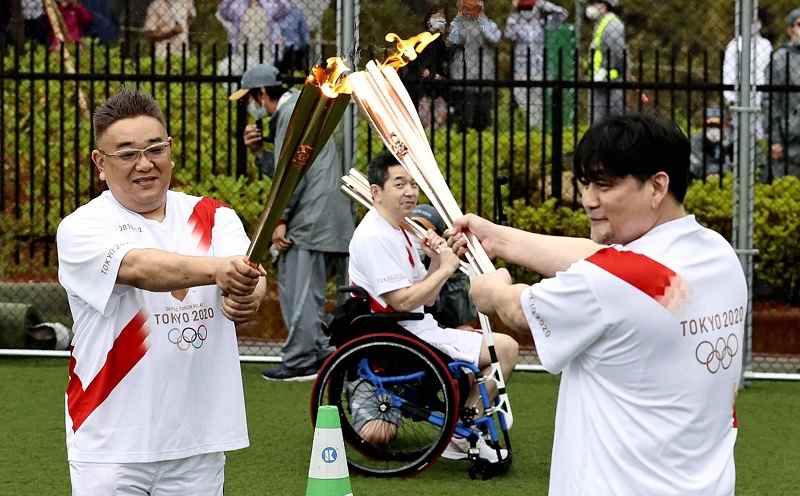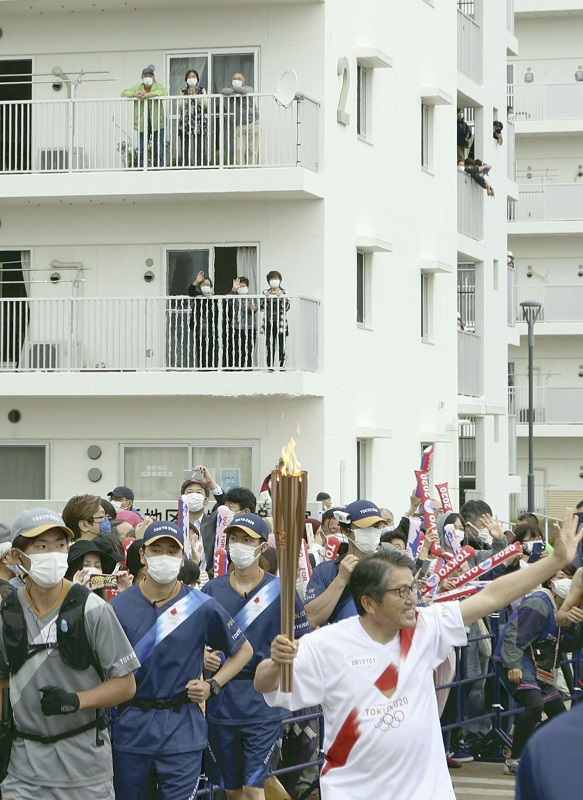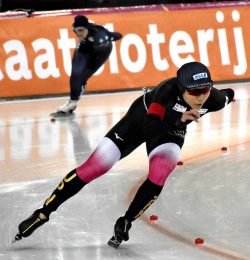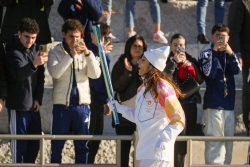
The comedy duo Sandwichman hold torches at a school in Onagawa, Miyagi Prefecture, on Saturday. No spectators were allowed.
16:57 JST, June 20, 2021
The Olympic torch relay continues along its difficult road, recently entering its 40th prefecture — Miyagi, an area severely battered by the Great East Japan Earthquake.
As a result of the pandemic, plans to carry the torch along public roads have been canceled in 16 prefectures, or 40% of the total, since the relay began on March 25. The Tokyo metropolitan government is also preparing to cancel parts of the torch’s passage along public roads, and some local governments are deciding to hold related ceremonies with no spectators.
The “flame of hope” keeps proceeding toward its goal, buffeted by strong headwinds all the way.
Reading out names
The first leg of the relay in Miyagi Prefecture started at a public housing complex for disaster victims in Kesennuma. Amid drizzling rain, spectators wearing masks gathered along the road, while others watched from the balconies of their units to avoid forming crowds.
“It’s a little disappointing that we can’t hold the relay in a spectacular way,” said Nobuo Saito, 79, head of a local residents association. “But we’re here today in Kesennuma, which has been rebuilt over the 10 years since the disaster, and I feel like a light has come on inside my heart.”
The comedy duo Sandwichman ran on school grounds in Onagawa in the prefecture, with no spectators allowed inside. The last leg of the relay in the prefecture is slated for Monday, but its scheduled passage along public roads in Sendai was partly canceled because it will take place around the time that many people come home, making crowds inevitable.
According to prefectural governments and the Tokyo Organising Committee of the Olympic and Paralympic Games, nine prefectures, including Osaka, Fukuoka, Ishikawa and Hokkaido, decided not to allow the torch to be carried on any public roads, to avoid crowding and curb the flow of people.
Seven prefectures, including Ehime, Kumamoto and Aomori, partly canceled plans to run on public roads.
Nineteen prefectures held ceremonies without spectators, and six prefectures had no spectators along some of the relay routes.
Many runners who could not travel along public roads instead participated in the ceremonies or ran along an empty course. In Okinawa Prefecture, which remains under emergency-level priority measures against the novel coronavirus, no alternative measures were provided for 14 people who were scheduled to run in Miyakojima.
In Hokkaido, which was under a state of emergency when its portion of the relay took place, plans to run along public roads were canceled. Ceremonies without spectators were held instead in Shiraoi and Sapporo.

People watch the relay from the balconies of a public housing complex for disaster victims in Kesennuma, Miyagi Prefecture, on Saturday.
At these events, representatives of the scheduled runners lit a flame stand with the torch, and the names of about 200 people who were supposed to participate in the relay in 18 cities and towns were read out one by one. The ceremonies were streamed online.
After passing through Miyagi Prefecture, the relay will continue to Tokyo and six prefectures. Shizuoka Prefecture has decided to partly cancel the use of public roads in the legs scheduled to start Wednesday.
Kanagawa Prefecture, where the relay will start on June 28, and Chiba Prefecture have both decided not to carry the torch along any public roads.
Constant tension
Eleven people involved in the torch relay, including a police officer, have so far been found to be infected with the virus. In Saga Prefecture, the driver of a vehicle used in the relay tested positive. This person ate meals face-to-face with colleagues on multiple occasions, in violation of the rules.
About 460 staff members from Tokyo are accompanying the relay.
“Letting our guard down against infection is strictly prohibited, so we’re constantly on edge,” said a senior organizing committee official.
The committee has asked torchbearers to be extremely careful regarding their health and to avoid eating out and going to crowded places for two weeks before taking part in the relay. In one case, a runner dropped out of the relay because of poor health, but no runners have so far been infected with the virus, according to the committee.
The committee is also struggling to cope with crowded roadside areas, which have been a problem in many places. A helicopter is used to monitor the routes, and the committee checks Twitter. When there are posts indicating that there may be crowding, the committee repeatedly calls for caution until the runners have passed.
"Sports" POPULAR ARTICLE
-

Speed Skater Yukino Yoshida Clinches Ticket to Milan
-

Yoshinobu Yamamoto Cheered by Los Angeles Lakers Fans at NBA Game
-

Kenta Maeda Joins Rakuten Eagles; Returns from American MLB to Japanese Pro Baseball for First Time Since 2015
-

Maruyama’s Ski Jump Streak Snapped
-

Sumo Wrestler Aonishiki ‘Gives Courage to Ukraine,’ Says Childhood Mentor
JN ACCESS RANKING
-

Tokyo Economic Security Forum to Hold Inaugural Meeting Amid Tense Global Environment
-

Keidanren Chairman Yoshinobu Tsutsui Visits Kashiwazaki-Kariwa Nuclear Power Plant; Inspects New Emergency Safety System
-

Imports of Rare Earths from China Facing Delays, May Be Caused by Deterioration of Japan-China Relations
-

University of Tokyo Professor Discusses Japanese Economic Security in Interview Ahead of Forum
-

Japan Pulls out of Vietnam Nuclear Project, Complicating Hanoi’s Power Plans
























